From the riverside stalls of Phnom Penh to the markets of Battambang, Cambodia dishes up a vibrant range of flavours, textures, and time-honoured techniques. Whether you’re a curious foodie tracing the spice trails of Southeast Asia, or simply fuelling up between temple visits, you’ll find something to savour wherever your tastebuds lead you. From fragrant street-side broths to refined takes on royal recipes, this travel guide will see you grazing your way through Cambodia’s edible heritage, one spoonful of kroeung, prahok, or galangal at a time…
What Makes Cambodian Food Unique?
Rooted in centuries-old techniques and shaped by its rivers, rice paddies and trade routes, Cambodian food stands apart for its bold, herby pastes, fermented flavours, and delicate balance of sweet, sour, salty and bitter in every dish.
Cambodia sits at the crossroads of Southeast Asia, sharing borders with Thailand, Laos, and Vietnam and wedged between the Mekong River and the Gulf of Thailand (get your bearings with this handy map). Its lush lowlands, floodplains, and coastal estuaries support a cuisine deeply connected to the rhythms of the land and water, with verdant fields, fish-rich rivers, and tropical crops all shaping the daily menu.
Cultural influences have also long played their part. Long before foreign powers arrived, the ancient Khmer Empire had established Cambodia’s culinary profile, and their signature flavours – lemongrass, turmeric, galangal, fermented fish paste (prahok), and palm sugar – still anchor many of the Kingdom’s favourite dishes.
French colonial rule in the 19th and 20th centuries also left their mark. Baguettes are still a staple in Cambodian breakfasts, while coffee culture has blended French drip techniques with condensed milk and local beans. Indian and Chinese influences have subtly taken root, too. But unlike its spicier Thai neighbour or Vietnam’s sharper, herb-driven plates, Cambodian cooking leans into depth rather than heat, with coconut milk softening complex curry pastes. Rice is central, both as a staple and a base for creativity, and meals are served family style, with each dish plated up generously, designed to be shared.
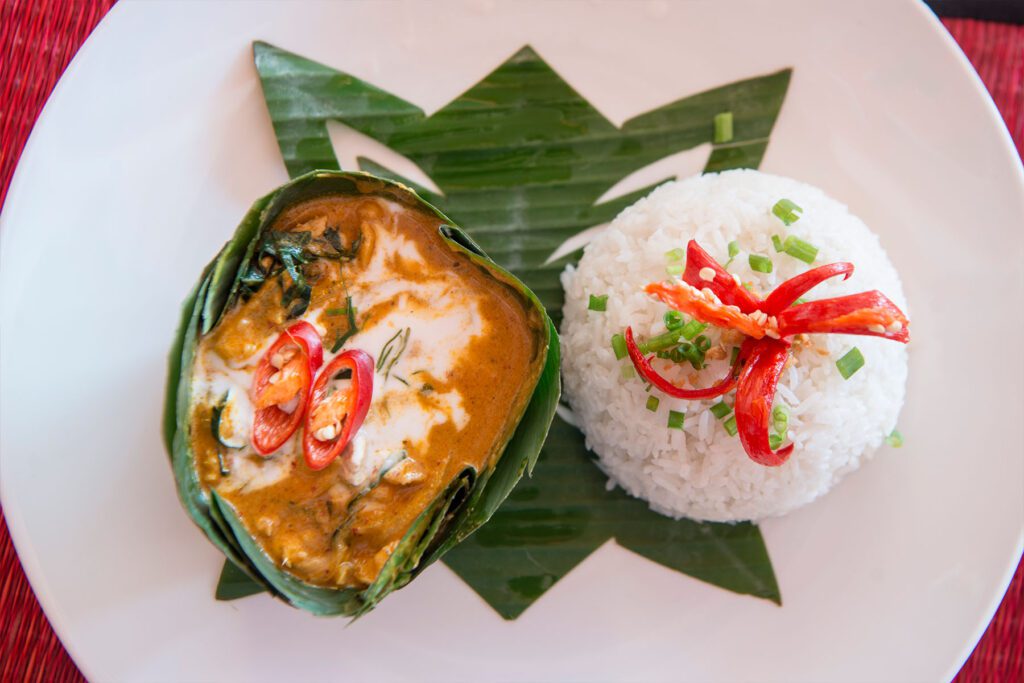

Iconic Cambodian Dishes You Have to Try
Steeped in history, rich in flavour and unapologetically moreish, these classics serve the nation’s heritage on a platter.
Fish Amok (steamed fish curry)
Often hailed as Cambodia’s national dish, this delicacy features freshwater fish – such as catfish or snakehead – marinated in a fragrant kroeung paste made with lemongrass, galangal, turmeric and kaffir lime leaves. It’s combined with coconut milk, then steamed in banana leaf cups to create a custard-like texture that’s both rich and aromatic.
Nom Banh Chok (Khmer noodles)
A beloved breakfast dish of rice noodles topped with a green fish curry made from lemongrass, turmeric and other herbs. It’s garnished with crisp raw vegetables such as cucumber, banana blossom and basil.
Bai Sach Chrouk (grilled pork and rice)
A popular morning meal featuring thin slices of pork marinated in coconut milk, garlic and palm sugar, then grilled over charcoal. Served with steamed rice, pickled vegetables and sometimes a light broth.
Kuy Teav (noodle soup)
A traditional breakfast noodle soup with a clear pork broth, rice noodles and assorted toppings like sliced pork, beef or seafood. It’s finished with herbs, lime, and chilli for extra depth and brightness.
Lok Lak (stir-fried beef)
Marinated in a blend of soy sauce, oyster sauce and black pepper, the beef is quickly stir-fried and served over lettuce, tomatoes and onions, often with a fried egg on top and a lime-pepper dipping sauce on the side.
Samlar Machu (sour soup)
A tangy, refreshing staple made with tamarind, pineapple and tomatoes, often simmered with fish or pork and fragrant local herbs. Varieties include samlar machu yuon (with fish) and samlar machu kroeung (with spice paste).
Sach Ko Ang (Cambodian BBQ)
Beef or pork marinated in lemongrass, garlic and spices, then grilled over an open flame. Common at markets and celebrations, it’s served with pickled vegetables and dipping sauces.
Kampot Pepper Crab
A coastal speciality from Kampot and Kep, this dish pairs ocean-fresh crab with the region’s prized green peppercorns. Stir-fried with garlic, shallots and savoury sauce, it highlights the pepper’s complexity and heat.
Follow your tastebuds from Siem Reap to Battambang on our fully customisable, 6-night Flavours of Cambodia holiday.
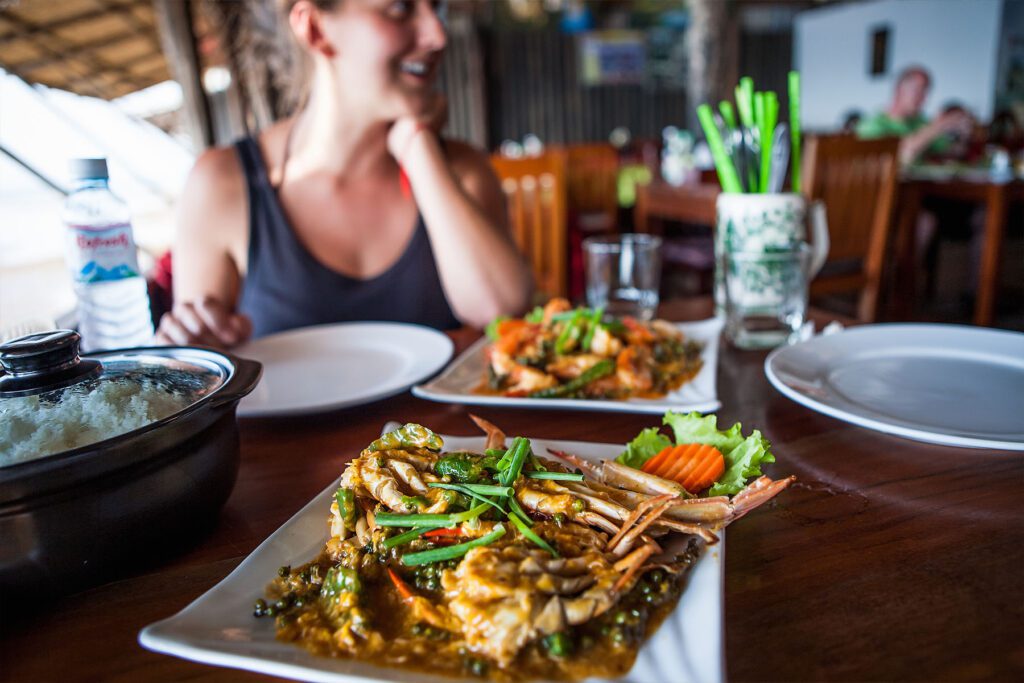

Lesser-Known Local Favourites
Loved locally but rarely sampled by travellers, these dishes offer an authentic taste of everyday Cambodia – and that’s exactly why you should try them.
Lort Cha (stir-fried rice pin noodles)
A beloved street food made with short, chewy rice-pin noodles stir-fried with garlic, beansprouts and scallions, then seasoned with palm sugar, fish sauce and dark soy. Topped with a fried egg and served hot with chilli sauce and lime, it’s a quick, flavour-packed favourite – especially popular as an afternoon snack or late-night bite from roadside stalls.
Pleah Sach Ko (beef ceviche)
This vibrant salad of thinly sliced raw beef cured in lime juice is a festive favourite, bursting with bold contrasts: zesty citrus, umami-rich prahok, fresh herbs and hot chilli. Tossed with lemongrass, shallots, mint and peanuts for crunch, it’s a punchy showcase of Khmer flavour balance – though rarely found on tourist menus due to its raw preparation.
Samlar Kari (Khmer chicken curry)
A gently spiced curry of chicken, sweet potato and eggplant simmered in coconut milk and kroeung paste, it’s fragrant rather than fiery. Milder than Thai or Indian curries, this comforting local favourite is often served with rice or a baguette – though its subtlety means it’s often overlooked by travellers.
Yaohon (hot pot)
A coconut-based hot pot enjoyed at gatherings like Lunar New Year, yaohon invites diners to cook meats, seafood, vegetables and noodles in a simmering lemongrass-scented broth. Customisable and communal, it’s as much about the shared cooking and dining experience as the flavour – though it’s rarely found outside homes or public celebrations. A grilled version, known as buttered yaohon, is also a favourite.
Lap Khmer (beef salad)
This bright, spicy salad features thin slices of beef lightly marinated in lime juice, then tossed with chilli, shallots, mint and basil. Zesty and herb-packed, it’s a refreshing contrast to richer dishes – often made at home with herbs straight from the garden.
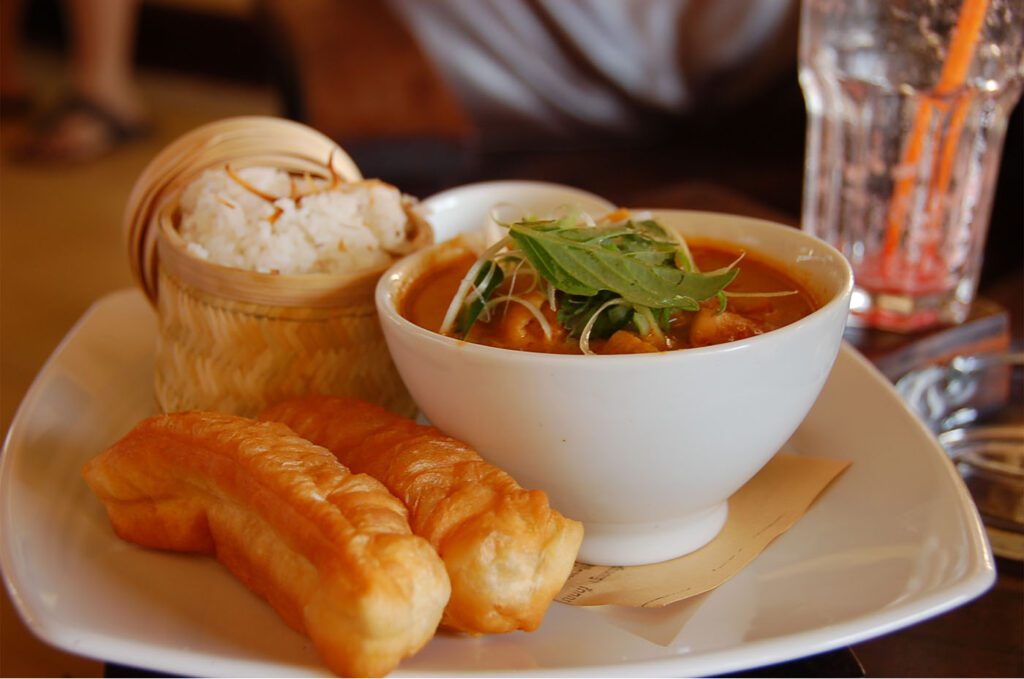

Cambodian Sweets and Desserts
Rather than being staples of tourist menus, these treats are traditionally part of festivals, family gatherings and religious offerings, and are most often homemade or found in smaller markets.
Num Ansom Chek (sticky rice banana cake)
A beloved Khmer sweet made by wrapping sticky rice soaked in coconut milk around ripe bananas, then steaming it in banana leaves until tender. Often prepared during Pchum Ben (Ancestor’s Day, usually in September or October) and Khmer New Year, it’s a treat that symbolises kinship and continuity.
Sangkhia (pumpkin custard)
A festive favourite, this is traditionally served at weddings and New Year celebrations. It’s made by filling a whole pumpkin with a smooth custard of coconut milk, palm sugar and eggs, then steaming it until set. It’s then sliced into golden wedges, revealing creamy custard encased in tender pumpkin flesh.
Chet Chien (fried bananas)
Ripe banana slices are wrapped in a light batter – usually made from rice flour and coconut milk – then deep-fried until crisp and golden. The result is a crunchy shell with a sweet, gooey centre, sometimes served with powdered sugar or ice cream. You’ll find this popular street food at markets across the country.
Our 5-day Authentic Angkor journey pairs Cambodia’s ancient temples with a delicious immersion in local flavours.
Adventurous Eats: Insects and Unusual Snacks
Cambodian dishes reflect a deep tradition of using all parts of an animal, foraging from the land, and preserving foods for flavour and longevity. And while you might encounter unusual dishes like grilled snake and fried frogs on your travels, insect-based snacks are readily available far and wide.
During the Khmer Rouge regime in the late 1970s, food scarcity pushed many Cambodians to rely on what they could find in the fields and forests. Packed with protein and easy to forage, bite-sized bugs like crickets, grasshoppers, silkworm pupae, giant water bugs and spiders became a lifeline.
Today, these crunchy snacks still feature prominently in Cambodian street food, especially in the night markets of Phnom Penh and Siem Reap, where vendors sell them hot, spiced and by the bag. One of the most talked-about delicacies is deep-fried tarantula – especially associated with the market town of Skuon in Kampong Cham province. Typically marinated with garlic and salt, the spiders are fried whole, leaving them crispy on the outside and soft within.
For a deeper look at how these uncommon ingredients intersect with Cambodian culture, join a guided culinary walk to see how the insects are prepared. For example, our Flavours of Cambodia holiday includes a street food discovery tour in Siem Reap, offering plenty of opportunities to taste your way through these bold local favourites.
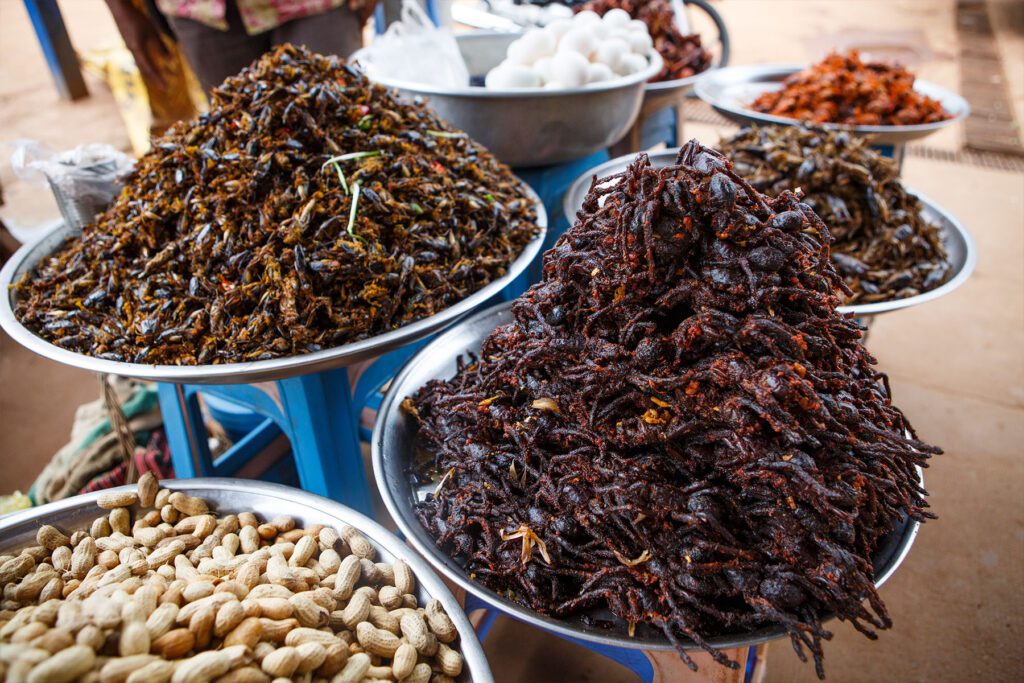

Vegetarian and Vegan Options in Cambodian Cuisine
Cambodia offers a variety of vegetarian and vegan dishes that are both tasty and filling – particularly in urban areas like Phnom Penh and Siem Reap, where you’ll find plenty of restaurants catering to plant-based diets with a mix of local and international dishes. In saying that, it’s important to note that fish sauce, meat-based broths and other animal-derived ingredients are commonly used in traditional cooking, even in vegetable dishes – and especially in rural areas. So, if you have any concerns, chat with the restaurant team before you order, and look for these classics:
Amok Tofu
A vegan take on Cambodia’s national dish, this version replaces fish with tofu, steamed in banana leaves with a fragrant blend of coconut milk, lemongrass and spices.
Nom Banh Chok
Rice noodles topped with a green curry gravy made from lemongrass, turmeric and kaffir lime leaves, garnished with fresh herbs and raw vegetables. It’s vegan-friendly when made without fish sauce.
Chha Trob
A stir-fried eggplant dish that can be made vegan by swapping minced pork for tofu and replacing fish sauce with soy or mushroom sauce.
This spectacular 8-day adventure takes in three very different Cambodian cities and Makes Travel Matter.
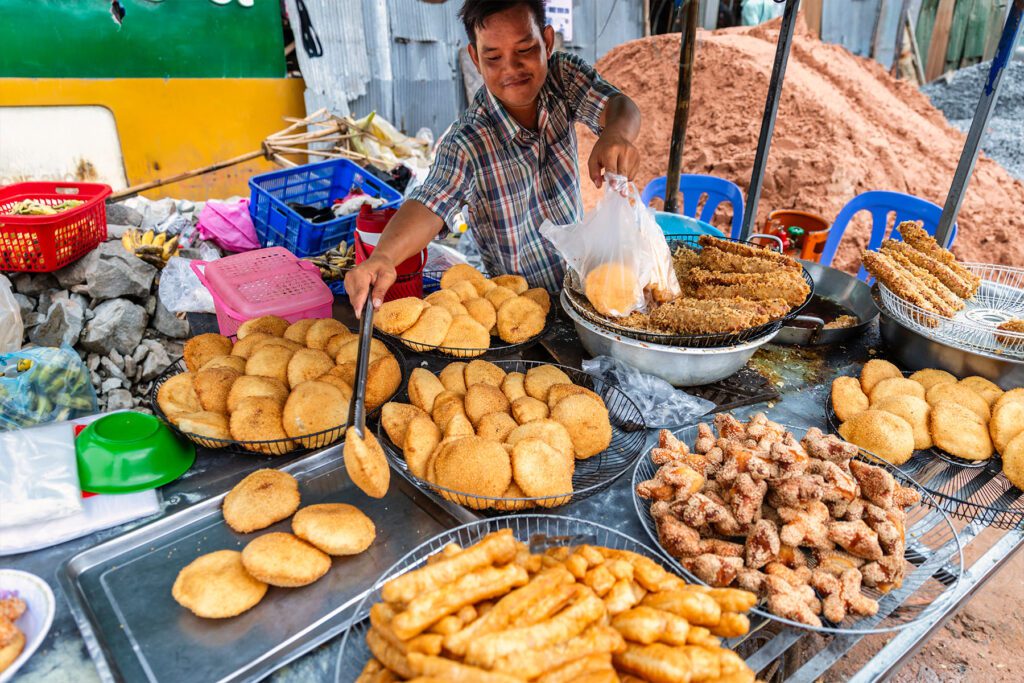

Where to Try These Dishes
Cambodia’s dining scene is a vibrant blend of street food, bustling markets, diverse restaurants, and immersive dining experiences that Make Travel Matter:
Street food & markets
Phnom Penh’s Phsar Thmei (central market) and its local night market are both hubs for local delicacies, snacks and mains. In Siem Reap, Psah Chas (old market) has a wide range of traditional foods and souvenirs, making it a favourite with both locals and travellers. Around the market, the streets are lined with stalls selling pancakes, fruit shakes, fried bananas, waffles, coconut rice cakes, and various rice and noodle dishes. The surrounding streets of Wat Polanka are also packed with vendors selling grilled meats, coconut rice cakes, and more local bites.
Restaurants
For a refined dining experience, Malis has branches in Phnom Penh and Siem Reap, and serves traditional Khmer cuisine with a modern twist, emphasising fresh, local ingredients. In Siem Reap, Cuisine Wat Damnak has a seasonal menu showcasing lesser-known Cambodian dishes, earning it a spot among Asia’s top restaurants. And Embassy Restaurant presents its fine-dining feasts with multiple-course set menus and stellar wine pairings, while Chanrey Tree serves refined renditions of classic Khmer dishes, many made to the owner’s family recipes.
Special culinary experiences
Throughout the country, unique tours and immersions not only take you deep into the community, they ensure you’re giving back to it. In Battambang, you can MAKE TRAVEL MATTER® at Jaan Bai’s table – a social enterprise restaurant established by the Cambodian Children’s Trust to train and employ disadvantaged youths. As part of our Flavours of Cambodia holiday, you’ll also tour more of the town’s foodie highlights, including the award-winning Kinyei Café, dumpling hotspot Chov Khorko Miteanh, and street-food tastings at riverside stalls.
In Siem Reap, quench you thirst with a Khmer cocktail lesson at the Asana Khmer Herbal Bar and sip behind the scenes at the Sombai rice spirit tasting rooms. And at Haven Restaurant, the feelgood thrill of giving back makes your meal even more satisfying, with the social enterprise eatery offering hospitality programs and employment opportunities to underprivileged locals.
Final Tips for Eating in Cambodia: Etiquette, Safety and Hygiene
Here, just a few simple tips to help you get the most out of your Cambodian dining adventures.
- You’ll mostly use cutlery, not chopsticks. Most locals eat with a spoon and fork; the fork goes in your left hand to push food onto the spoon in your right.
- Wash your hands before and after eating. This is particularly important when dining at street stalls or traditional eateries, and in rural areas where many meals are eaten by hand.
- Eat with your right hand. Left is considered unclean in traditional etiquette.
- Copy the locals. Watch what locals order and how they eat it – this is a great cue for both etiquette and the tastiest options. And choose where you eat based on how busy places are: high customer turnover usually means fresher food and better hygiene.
- Don’t point with your chopsticks or utensils. It’s considered rude to gesture with cutlery or to stick utensils upright in a bowl of rice.
- Share your meals. Khmer meals are typically communal, so order a few dishes for the table to share.
- Taste before you season. Before adding condiments like fish sauce or chilli, it’s respectful to try the food as it is first served. Changing the flavour first can seem dismissive of the cook.
- Be cautious with raw foods and water. Unless you’re in a high-end restaurant, avoid raw vegies and salads, as they may have been washed in untreated water. In markets, opt for food you can see being cooked in front of you to guarantee freshness. Also, choose fruit with peelable skins (like bananas or mangoes), and wash them thoroughly with bottled or boiled water.
